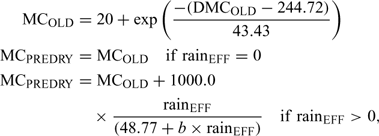An index for tracking sheltered forest floor moisture within the Canadian Forest Fire Weather Index System
B. M. Wotton A D , B. J. Stocks A B and D. L. Martell CA Great Lakes Forestry Centre, Canadian Forest Service, Natural Resources Canada, 1219 Queen St E., Sault Ste. Marie, ON P6A 2E5, Canada.
B Email: bstocks@nrcan.gc.ca
C Faculty of Forestry, University of Toronto, 33 Willcocks St, Toronto, ON M5S 3B3, Canada. Email: martell@smokey.forestry.utoronto.ca
D Corresponding author. Present address: Faculty of Forestry, University of Toronto, 33 Willcocks St, Toronto, ON M5S 3B3, Canada. Telephone: +1 416 526 0774; fax: +1 416 978 3834; email: mike.wotton@utoronto.ca
International Journal of Wildland Fire 14(2) 169-182 https://doi.org/10.1071/WF04038
Submitted: 10 August 2004 Accepted: 1 February 2005 Published: 17 May 2005
Abstract
The Duff Moisture Code (DMC) component of the Canadian Forest Fire Weather Index (FWI) System is used by fire management agencies across Canada as an indicator of the susceptibility of the forest floor to lightning fire ignition. However, this model was developed for the moisture content of the forest floor away from the sheltering influences of overstory trees, an area where lightning strikes usually ignite the forest floor. Through destructive sampling of the forest floor in a mature jack pine stand in northern Ontario over several summers, the moisture content of the forest floor in sheltered areas close to the boles of dominant overstory trees was found to be significantly lower than in other less heavily sheltered areas of the stand. Observations from a network of in-stand rain gauges revealed that rainfall penetration through the canopy (throughfall) was correlated with both open rainfall amount and the duration of a storm. Observed throughfall amounts were used to develop a throughfall relationship for extremely sheltered locations (within ~0.5 m of the boles) in a mature jack pine stand. This throughfall model was used, along with differences in forest floor drying rate, to develop a new duff moisture index for strongly sheltered areas of the forest floor. Calculated values of this new moisture model, which has the same daily weather observation requirements as the FWI System’s DMC model, were found to match observed moisture contents quite well.
Additional keywords: duff moisture; fire danger; fire management; lightning fire occurrence.
Beall HW (1934) The penetration of rainfall through hardwood and softwood forest canopy. Ecology 15, 412–415.
Flannigan MD , Harrington JB (1988) A study of the relation of meteorological variables to monthly provincial area burned by wildfire in Canada (1953–1980). Journal of Applied Meteorology 27, 441–452.
| Crossref | GoogleScholarGoogle Scholar |
Liu SG (1997) A new model for the prediction of rainfall interception in forest canopies. Ecological Modelling 99, 151–159.
| Crossref | GoogleScholarGoogle Scholar |
Nalder IA , Wein RW (1997) A new forest floor corer for rapid sampling, minimal disturbance and adequate precision. Silva Fennica 32, 373–382.
Rutter AJ, Morton AJ , Robbins PC (1975) A predictive model of rainfall interception in forests. II. Generalization of the model and comparison with observations in some coniferous and hardwood stands. Journal of Applied Ecology 12, 367–380.
Stocks BJ (1987) Fire behaviour in immature jack pine. Canadian Journal of Forest Research 17, 80–86.
Van Wagner CE (1972) Duff consumption by fire in eastern pine stands. Canadian Journal of Forest Research 2, 34–39.
† Le is assigned monthly mean values for typical fire season months: Le(April) = 12.8, Le(May) = 13.9, Le(June) = 13.9, Le(July) = 12.4, Le(August) = 10.9, Le(September) = 9.4. These values are mean number of hours of sunlight minus 3 hours for each month [as calculated for an area near Chalk River, Ontario (approximately 46°N and 76°W) where the DMC model was developed] except for April and May where full day length is used.
‡ Vapour pressure deficit was calculated by the standard formulation described in (Baumgartner et al. 1982) Vpd = 6.11 × exp(17.27 × T/(T+237.31)) × (100-RH)/100.
¶ The development of SDMC based models of lightning fire ignition are also described in a paper accepted for publication at the Canadian Journal of Forest Research ‘Wotton, B.M. and Martell, D.L. A lightning fire occurrence model for Ontario.’
Appendix 1
The required inputs are noon weather station readings of temperature, relative humidity and 24 h accumulated rainfall. The same daylength factor used in the calculation of drying rate is the same factor used in the DMC model. These values are given in Table A1 below. The previous day’s value of SDMC is also needed for the calculation.
The calculation of SDMC is as follows:


where:


where rain is the 24 h accumulated rainfall; Temp is the noon screen level air temperature; RH is the noon screen level relative humidity; rainEFF is a variable that describes the effective amount of rain penetrating through to the forest floor; and MCPREDRY is the moisture content of the forest floor, after any potential rain but before the days drying.


